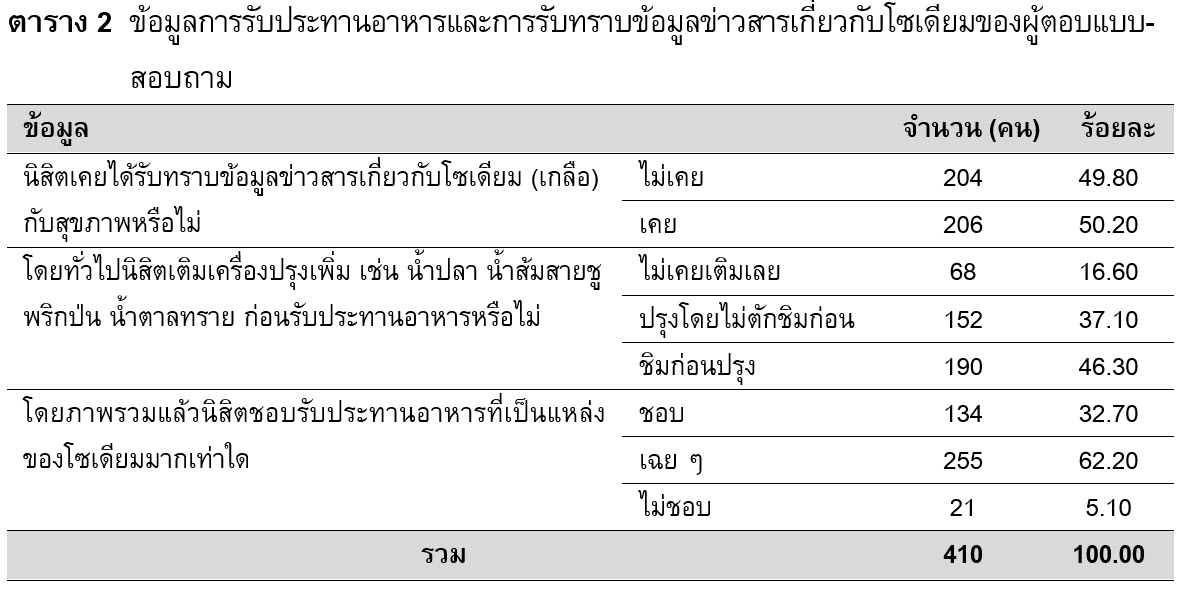ปัจจัยที่มีความสัมพันธ์กับโซเดียมจากอาหารที่บริโภคของนิสิต มหาวิทยาลัยศรีนครินทรวิโรฒ ประสานมิตร
Main Article Content
Abstract
Sirimon Chaikate
รับบทความ: 9 เมษายน 2559; ยอมรับตีพิมพ์: 30 พฤษภาคม 2559
บทคัดย่อ
งานวิจัยนี้มีวัตถุประสงค์เพื่อศึกษาปริมาณโซเดียมในอาหารที่บริโภคและปัจจัยที่มีความสัมพันธ์กับปริมาณโซเดียมในอาหารที่บริโภค จากกลุ่มนิสิตมหาวิทยาลัยศรีนครินทรวิโรฒ ประสานมิตร จำนวน 410 คน จากจำนวนนิสิต 18,869 คน (ยามาเน่) เครื่องมือในการเก็บรวบรวมข้อมูล ได้แก่ แบบสอบถาม เครื่องวัดความดันโลหิตแบบดิจิทัล สายวัดตัว หุ่นจำลองอาหาร สถิติที่ใช้ในการศึกษา ได้แก่ ร้อยละ ค่าเฉลี่ย ส่วนเบี่ยงเบนมาตรฐาน สถิติไคสแควร์ โปรแกรม Inmucal-Nutrients สถาบันโภชนาการ มหาวิทยาลัยมหิดล ผลการวิจัยพบว่า ผู้ตอบแบบสอบถามเป็นเพศหญิงร้อยละ 65.60 เพศชายร้อยละ 34.40 ผู้ตอบแบบสอบถามส่วนใหญ่มีภาวะโภชนาการปกติ (Body Mass Index, BMI 18.5 – 22.99 kg/m2) คิดเป็นร้อยละ 53.40 ค่าความดันโลหิตโดยเฉลี่ย 117 / 74 มิลลิเมตรปรอท ส่วนใหญ่ซื้ออาหารสำเร็จรูปมารับประทานร้อยละ 73.20 นอกจากนี้นิสิตร้อยละ 29.50 ชอบรับประทานอาหารรสเค็ม รองลงมาคือรสหวานร้อยละ 23.90 และรสเปรี้ยวร้อยละ 19.30 ตามลำดับ ผลการศึกษาความถี่การบริโภคอาหารที่เป็นแหล่งของโซเดียมพบว่าผู้ตอบแบบสอบถาม ส่วนใหญ่รับประทานไส้กรอกในระดับบ่อยๆ (3 – 6 ครั้งต่อสัปดาห์) ร้อยละ 29.02 รองลงมา ได้แก่ บะหมี่กึ่งสำเร็จรูปร้อยละ 27.56 และน้ำปลา ร้อยละ 26.58 ตามลำดับ ปริมาณโซเดียมโดยเฉลี่ยจากอาหารที่บริโภค 2,113.97 มิลลิกรัมต่อวัน การศึกษาปัจจัยที่มีความสัมพันธ์กับปริมาณโซเดียมในอาหารที่บริโภคอย่างมีนัยสำคัญทางสถิติ ได้แก่ ปัจจัยด้านการรับรู้ข้อมูลข่าวสารเกี่ยวกับโซเดียม (p < 0.05)
คำสำคัญ: โซเดียม อาหาร นิสิตมหาวิทยาลัยศรีนครินทรวิโรฒ
Abstract
The objectives of this research were to study the quantity of sodium in food consumption and factors associated with the quantity of sodium in food consumption among 410 students from 18,869 students (Taro Yamane’s equation) at Srinakharinwirot University, Prasarnmit campus. The instruments used for data collection were questionnaires, blood pressure monitor (digital), tape measure, and food models. Statistical analysis were in term of percentage, mean, standard deviation, chi-square test, and Inmucal-Nutrients Program from Institute of Nutrition, Mahidol University. The results were found 65.60% females and 34.40% males. Majority of students (53.40%) was normal nutritional status (Body Mass Index; BMI 18.5 – 22.99 kg/m2). The average of blood pressure was 117 / 74 mmHg. Most of participants purchased ready to eat foods (73.20%). Apart from this, the percentage which they like salty, sweet and sour were 29.50%, 23.90% and 19.30%, respectively. The result of the frequency of food containing sodium intake (3-6 times/ week) were sausage (29.02%), instant noodle (27.56%) and fish sauce (26.59%). The mean of sodium intake from food consumption was 2,113.97 mg/day. Factor associated with sodium in food consumption significantly was perception of news about sodium (p < 0.05).
Keywords: Sodium, Food, Students of Srinakharinwirot University
Downloads
Article Details

This work is licensed under a Creative Commons Attribution-NonCommercial 4.0 International License.
References
Nopchinda, S., and Warawit, W. (2003). Sodium. In Dietary Reference intake for Thais 2003. 3rd ed. Bangkok: Printing and Shipping Organization Phatduphan. (in Thai)
Food and Nutrition Policy for Health Promotion (FHP). (2013). The fact of sodium. The fact that you and your family to know. Food Policy and Nutrition Research Newsletter 2(2): 1–10.
Taylor, R. S., Ashton, K. E., Moxham, T., Hooper, L., and Ebrahim, S. (2015). Reduced dietary salt for the prevention of cardiovascular disease (Review). Retrieved from http://www.thecochranelibrary.com, December 10, 2015.
Hanevold, C. D. (2013). Sodium intake and blood pressure in children. Current Hypertension Reports 15(5): 417–425.
Project–driven campaign to reduce the consumption of salt (sodium) in Thailand. (2013). Reducing salt intake Network. Retrieved from http://www.lowsaltthailand.org/about.html, October 10, 2015.
Batcagan-Abueg, A. P. M., Lee, J. J., Chan, P., Rebello, S. A., and Amarra, M. S. (2013). Salt intakes and salt reduction initiatives in Southeast Asia: A review. Asia Pacific Journal of Clinical Nutrition 22(4): 490– 504.
U.S. Department of Health and Human Services. (2016). New research: Excess sodium intake remains common in the United States. Centers for Disease Control and Prevention 1: 1–2.
Health Canada. (2012). Sodium in Canada. Food and Nutrition. Retrieved from http://www. hc-sc.gc.ca/fn-an/nutrition/sodium/index-eng.php, May 14, 2016.
Grimes, C. A., Campbell, K. J., Riddell, L. J., and Nowson, C. A. (2013). Is socioeconomic status associated with dietary sodium intake in Australian children? A cross-sectional study. British Medical Journal Open 3(2): 1–7.
Cappuccio, F. P, Ji, Chen, Donfrancesco, C., Palmieri, L., Ippolito, L., Vanuzzo, D., Giampaoli, S., and Strazzullo, P. (2015). Geographic and socioeconomic variation of sodium and potassium intake in Italy: results from the MINISAL-GIRCSI programme. British Medical Journal Open 5(9): 1–11.
Chirawatkul, A. (2014). Statistics in Research: Appropriate Selection. Bangkok: Withayapat. (in Thai)
Institute for Population and Social Research, Mahidol University (IPSR-MU). (2015). Waist-Hip ratio. In Glossary of Terms in Population and Social Research. Retrieved from http://www.popterms.mahidol.ac.th, December 10, 2015.
Sangwatanaroj, S. (2015). Waist circumference should be less than half the height. Khon Thai Rai Poong Network. The Royal College of Physicians of Thai-land. Retrieved from http://www.raipoong. com, December 10, 2015.
Thai Hypertension Society. (2015). Hyper-tension. Retrieved from http://www.thai hypertension.org, December 10, 2015.
Llido, L. O., and Mirasol, R. (2016). Comparison of body mass index based nutritional status using WHO criteria versus “Asian” criteria: Report from the Philippines. PhilSPEN Online.
Wanijjakul, C. (2007). Program INMUCAL-
Nutrients. Nakhon Pathom: Institute of Nutrition, Mahidol University. (in Thai)
Kriengsinyos, W. (2012). Prolong Life, Reduce Sodium. Bangkok: Office Printing Business WVO. (in Thai)
